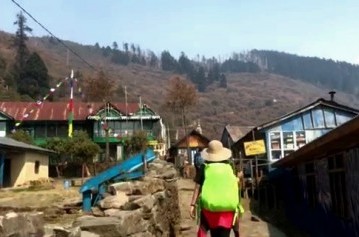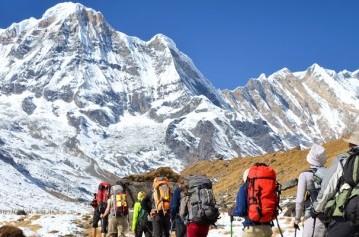
"The Langtang Region: Gateway to Himalayan Tranquility"
The Langtang Region is a beloved trekking destination in Nepal, renowned for its religious significance and serene beauty. Located only 19 miles north of Kathmandu and close to the border of Tibet, the Langtang Valley is encircled by Langtang National Park, offering trekkers an accessible yet immersive Himalayan experience.
The Langtang trek is notable for its proximity to Kathmandu, providing the shortest approach to snowy mountains from the capital. Starting from Syabru Besi after a nine-hour drive from Kathmandu, the trek follows the upstream Bhote Koshi River through ethnic Tamang and Sherpa villages, lush green forests, and diverse ecosystems.
Why Trek in the Langtang Region?
1. Cultural and Religious Significance
Langtang is a region rich in cultural heritage. The local Tamang and Sherpa communities maintain traditional lifestyles and customs, providing trekkers with an authentic cultural experience. The region is also home to several sacred sites, including the famous holy lake Gosaikunda, which holds great religious significance for Hindus and Buddhists.
2. Langtang National Park
The trek passes through Langtang National Park, a protected area that boasts a diverse range of flora and fauna. Trekkers can encounter rhododendrons, pine forests, red pandas, Himalayan black bears, and the elusive snow leopard. The park's natural beauty and biodiversity add to the allure of the Langtang trek.
3. Scenic Landscapes
The Langtang Valley is surrounded by snowy peaks and offers stunning alpine scenery. The trek takes you through picturesque valleys, past numerous lakes and glaciers, culminating in the expansive Kyanjin Valley, which is encircled by towering mountains on all sides.
4. Kyanjin Gompa and Kyanjin Ri
The trek reaches its pinnacle at Kyanjin Gompa (3,800 meters), a traditional monastery that provides panoramic views of the surrounding mountains. From here, trekkers can ascend Kyanjin Ri (4,350 meters), which offers a 360-degree view of the Langtang mountain range, a truly breathtaking experience.
Popular Trekking Routes of the Langtang Region
The Langtang Region offers a variety of trekking routes that cater to different levels of experience and interests. Here are some of the most popular trekking routes in the Langtang Region:
1. Langtang Valley Trek
Duration: 7-10 days
Difficulty: Moderate
Highlights:
- Trek through lush forests, traditional Tamang villages, and alpine meadows.
- Reach Kyanjin Gompa, a traditional monastery with panoramic views.
- Ascend Kyanjin Ri for stunning 360-degree mountain vistas.
- Explore Langtang National Park, home to diverse flora and fauna including red pandas and Himalayan black bears.
2. Langtang & Gosainkunda Trek
Duration: 10-14 days
Difficulty: Moderate to Challenging
Highlights:
- Visit the sacred Gosainkunda Lake, revered by Hindus and Buddhists.
- Experience diverse landscapes, from dense forests to alpine terrain.
- Enjoy stunning views of the Langtang and Ganesh Himal ranges.
- Opportunity to extend the trek to include the Helambu region.
3. Tamang Heritage Trail
Duration: 7-10 days
Difficulty: Moderate
Highlights:
- Immerse yourself in the rich culture of the Tamang people.
- Visit traditional villages, monasteries, and hot springs.
- Enjoy stunning views of the Langtang Lirung and Ganesh Himal.
- Experience traditional Tamang hospitality and local cuisine.
4. Helambu Trek
Duration: 7-10 days
Difficulty: Easy to Moderate
Highlights:
- Trek through beautiful Helambu villages with distinct Hyolmo culture.
- Enjoy scenic landscapes with terraced fields and rhododendron forests.
- Experience stunning mountain views without ascending to high altitudes.
- Accessible from Kathmandu, making it a convenient trekking option.
Essential Information
- Best Time to Visit: The best seasons for trekking in the Langtang Region are from March to May and September to November, when the weather is clear and stable, providing excellent views and comfortable trekking conditions.
- Trekking Permits: Trekkers need a Langtang National Park entry permit and a TIMS (Trekkers' Information Management System) card. Ensure all necessary permits are arranged in advance.
- Accommodation: A range of accommodation options, from basic teahouses to more comfortable lodges, are available along the trail. These provide rest and sustenance for trekkers, allowing them to experience local hospitality.
- Packing List: Essential items to pack include: Sturdy trekking boots, Warm clothing and layers, reliable map and compass, Personal medication and a first aid kit, good quality sleeping bag, Trekking poles, Sunscreen and sunglasses.
Embark on a trek in the the Langtang Region as it offers a trekking experience that combines cultural richness, natural beauty, and a sense of adventure. Whether exploring the sacred Gosaikunda Lake, encountering diverse wildlife in Langtang National Park, or ascending Kyanjin Ri for panoramic mountain views, the Langtang trek promises an unforgettable journey through one of Nepal's most accessible yet rewarding regions.
Experience the Langtang Region Trek with Asian Adventure Treks & Expedition - Professional Planner for your vacations!
Featured trips for Langtang Region
Easy trekking are basically for the beginners. This kind of treks is typically done in the lower hilly region of elevation below 3500 metre. The trails in this trek are generally vertical and walking time is 3 - 5 hours everyday.
Moderate types of trekking generally take place on the low altitude zone crossing the passes below the elevation of 4500 meters. Normally the walking is from 4 - 6 hours each day.
Hard kind of trekking routes crosses through the wild and adventurous trails and sometimes passes through the snow covered high passes between 4500 meters to 5500 meters. Usually the walks takes from 7-8 hours everyday.
Generally this types of routes are demanding long distance treks where the walks takes up to 9 hours each day. Each trail crosses at least one pass over 5500 meters frequently contains hardly ever explored regions. Challenging are the expedition types of activity.



